Review of Bluetooth Low Energy (BLE) Solutions (Updated 2022)
In this updated article we’ll review the current microchips and modules available for incorporating Bluetooth into your new product in 2022.
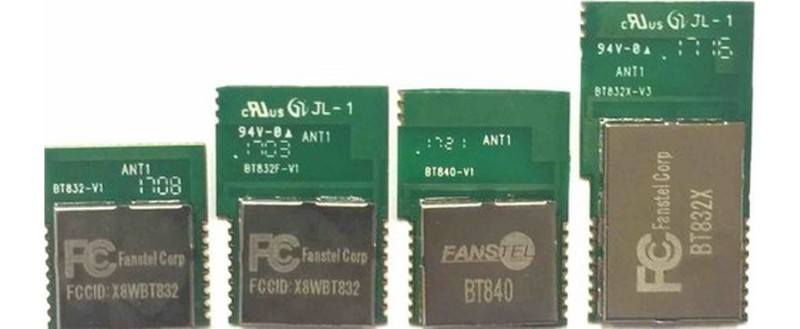
Bluetooth Low-Energy (BLE) is definitely one of the most popular technologies for new electronic hardware products. There are good reasons.
BLE is an extremely low power wireless technology that can be powered from a tiny battery for potentially years. Even better, it’s also relatively simple to implement and very affordable.
There are two ways to incorporate wireless functionality, such as BLE, into a new product: either use a module or use a System-on-a-Chip (SoC) solution.
For the majority of products I highly suggest that you begin with a module that includes a built-in antenna (all of the modules in this article include an antenna).
This is primarily due to the fact that a module will save you thousands of dollars in FCC certification fees and simplify development.
Also consider that anytime you add the integration of a custom or external antenna, you will introduce additional work and greater potential for bugs to your team.
It’s better to use a tried-and-tested antenna solution that works with your exact module unless a custom solution is absolutely necessary.
Later, once you reach higher manufacturing volumes you can migrate from a module solution to a chip solution so as to lower your product’s manufacturing cost and increase your profit margins.
Although, there are a couple of BLE modules that are priced so low that it might not ever make financial sense to switch to a custom SoC based solution.
A Bluetooth SoC is basically just a microcontroller with an embedded Bluetooth radio. For many products this chip can also serve as the master microcontroller for your product.
However, for more complex products a faster microcontroller may be used as your master controller, while the Bluetooth SoC acts as a peripheral device that interfaces with your primary microcontroller.
Although not absolutely essential, I highly recommend that you use a Bluetooth module that uses the same SoC that you may eventually use at higher manufacturing volumes. Doing so will make the transition a bit easier with less code rewrite required.
Perhaps somewhat surprisingly, many Bluetooth chip manufacturers don’t offer modules based on their chips. So in those cases the module manufacturer will be different from the chip manufacturer.
Mesh Networking with BLE
Up until 2017, BLE was generally a very limited communication method, only allowing one device to communicate with a single other device at time. Any BLE solution that would create a “network” of devices would still rely on a central hub to manage them all.
In 2017, however, Bluetooth Mesh was adopted as part of Bluetooth 5 to meet the growing needs of the IoT space, where it is incredibly common to see large groups of BLE devices in one place (think a smart home with dozens of lightbulbs with BLE capability).
So if you want a device with highly capable mesh networking, look for a Bluetooth 5 device. The bluetooth website provides a concise overview of what Bluetooth Mesh has to offer compared to its competitors like ZigBee.
Some notable differences include the fact that Bluetooth Mesh is a standard that defines the application layer all the way down to the underlying physical layer. This means that Mesh does not rely on any other standard to work.
Additionally, while other solutions are routing-based, Mesh is fully decentralized and relays messages using a controlled flooding method, in which one bluetooth device receives a message, and then propagates it to every other device in its vicinity.
Each device in turn sends the message on, until every device in the mesh network has received the message.
The flooding is managed such that a message will not make its way back to a device that previously had already sent the same message, preventing what is called a broadcast storm in which devices are continuously receiving and retransmitting messages they have already received.
The primary benefit of flooding compared to routing is that it makes networks much more scalable.
Bluetooth Mesh is able to create networks with hundreds or thousands of devices without significant hits in performance. It also reduces the performance requirements of individual modules.
Nordic Semiconductor
Chip Solution (Nordic nRF51822 / nRF52832)
Nordic Semiconductor is a leading manufacturer of Bluetooth SoC solutions. Both their nRF51822 and nRF52832 chips are quite popular.
One primary difference between the nRF51822 and nRF52832 is the core microcontroller. The nRF51822 uses a 32-bit ARM Cortex-M0 microcontroller running at 16 MHz.
Whereas the nRF52832 uses a much faster, more advanced 32-bit ARM Cortex-M4F microcontroller running at 64 MHz.
In fact, the nRF52832 has the fastest microcontroller of any of the purely BLE solutions reviewed. It even includes a floating point unit (FPU) which is what the ‘F’ in Cortex-M4F signifies.
The only solution with a faster processor is the Espressif ESP32, but that is really a different beast that consumes about 16 times more current than the nRF52832.
So if your product needs a really high performance microcontroller, yet power consumption must be kept small, then the nRF52832 is likely your best choice.
Also, the nRF52832 is Bluetooth 5 ready, whereas all of the other solutions only support the Bluetooth 4 specification. As a bonus, it also includes NFC capabilities.
The nRF52832 includes considerably more memory (FLASH and RAM), and even consumes less power than the nRF51822.
The only advantage to the nRF51822 is the lower price. However, the price difference is pretty minimal so I generally recommend the nRF52832.
One popular product you have likely seen recently that uses this module is the Apple Airtag, which is a nice stamp of approval from a huge hardware company that this device is a good performer in low-power applications.
The nRF52832 is available for $3.68 in quantities of 1000.
Given that it is an SoC, for many applications this is an extremely attractive price, especially for Bluetooth devices being manufactured in large quantities, as your device firmware as well as BLE may be handled by a single IC.
Module Solutions (Rigado BMD-200/300, Fanstel BT832)
As I mentioned previously, many Bluetooth SoC manufacturers don’t offer modules based on their chips. This is true with Nordic Semiconductor.
But fortunately there are many companies, including Rigado and Fanstel, that offer BLE modules based on Nordic chips.
The Rigado BMD-200 is based on the Nordic nRF51822, and the Rigado BMD-300 is based on the more powerful nRF52832.
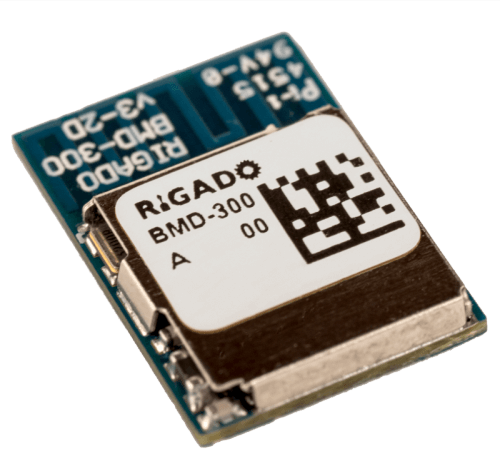
Rigado BMD-300 BLE module
Rigado also offers the BMD-350 which is an ultra-compact variant of the BMD-300 that measures only 6.4mm x 8.65mm x 1.5mm.
Fanstel offers a wide selection of BLE modules at almost half the cost of most other modules. In fact, Fanstel’s BLE modules are the lowest cost BLE modules I’ve seen available (except for the Espressif ESP32 module which I discuss later).
For example, the Rigado BMD-300 sells for $6.96 in quantities of 1k pieces , whereas the Fanstel BT832 sells for only $5.10.
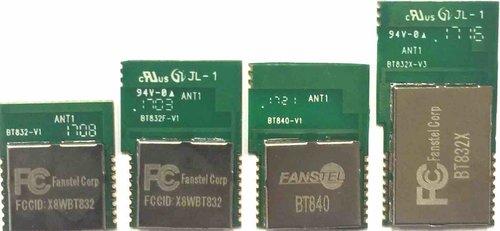
BLE modules from Fanstel based on the Nordic nRF52832 SoC
Fanstel also offers the BT832A which is based on the Nordic nRF52810 chip (a lower memory version of the nRF52822). The BT832A costs only $3.92 for quantities of 1k units.
Fanstel also offers various other longer range BLE modules based on the Nordic nRF52832. This includes the BT832X which has an operating range of 1,170 meters. The BT832X sells for $12.57 at volumes of 1k pieces.
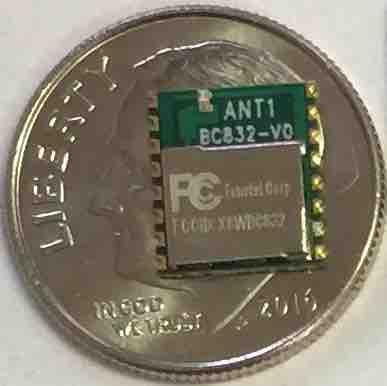
Fanstel BC832 BLE module on a quarter
The BC832 is their smallest module measuring only 7.8mm x 8.8mm x 1.3mm and it sells for $6.46 @ 1k pcs.
Finally, the smallest BLE module available (with an antenna) is the Taiyo Yuden EYSHSNZWZ module which measures only 3.25mm x 8.55mm x 0.9mm. It is also based on the Nordic nRF52832 SoC. It is available for $10.88 in quantities of 100.
Infineon Technologies (formerly Cypress Semiconductor)
Chip Solution (PSoC 4 BLE)
The PSoC 4 BLE chip solution from Infineon Technologies is based on an ARM Cortex-M0 microcontroller running at 48 MHz.
It incorporates up to 256 KB of FLASH memory and 32 KB of RAM memory. It consumes 18.7 mA of current while receiving data, putting this solution on the higher end of power consumption for the BLE modules reviewed.
The Infineon chip incorporates all of the standard microcontrollers functions including UART, I2C, SPI, I2S, timers, an ADC, and two DACs.
The Infineon PSoC 4 also provides up to 36 programmable GPIO pins, and it even includes 4 operational amplifiers to use for analog functions.
Module Solution (Cypress EZ-BLE)
Infineon is one of the manufacturers that makes both BLE chip solutions and module solutions based on their chips. They offer the EZ-BLE module which is one of the lower cost BLE modules available.
The EZ-BLE module sells for $5.10 @ volumes of 1k units. Infineon BLE modules are available as small as 10 mm x 10 mm x 1.8 mm, making it the third smallest module reviewed.
Texas Instruments
Since I was a design engineer for Texas Instruments for over 10 years it’s no secret that I really like TI products. Texas Instruments not only offers great products but they also provide some of the best technical support for startups.
Chip Solution (TI CC2650)
The Texas Instruments CC2650 not only provides BLE functionality but also supports ZigBee and 6LoWPAN wireless protocols.
The TI CC2650 is based on an ARM Cortex-M3 architecture microcontroller which is a faster, more advanced microcontroller than the Cortex-M0 architecture used in most of the other BLE chips.
Texas Instruments also offers an incredibly popular Internet of Things (IoT) development kit based on the CC2650 called the SensorTag.
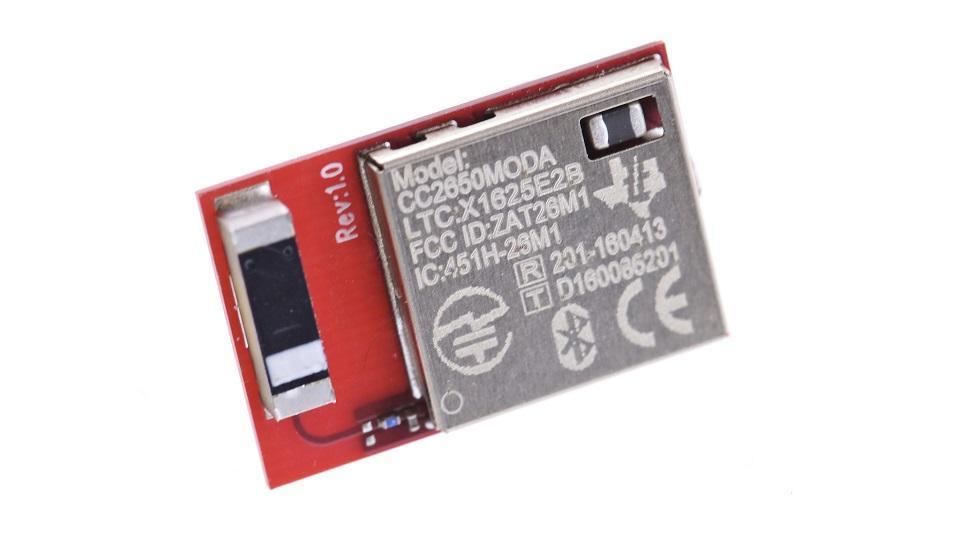
CC2650MODA BLE module from Texas Instruments
Module Solution (CC2650MODA)
Texas Instruments is one the manufacturers that offers a module based on their BLE SoC solution. The CC2650MODA module measures 16.9mm x 1mm, and costs $11.53 in quantities of 1.2k units.
Dialog Semiconductor
Dialog Semiconductor isn’t as well known as the other chip manufacturers I’ve discussed so far. However, they offer one of the lowest cost and lowest power consumption BLE chips available.
Chip Solution (DA1458x)
The DA1458x is based on a 32-bit ARM Cortex-M0 running at 16 MHz. It comes in two variants. The DA14583 includes 128 KB of FLASH memory, whereas the lower cost DA14580 instead includes 32 KB of One-Time-Programmable (OTP) memory.
In most cases, I recommend the DA14583 with its rewritable FLASH memory for development, and then the lower cost DA14580 with OTP for production. This strategy assumes that your firmware program is less than 32 KB.
The Dialog BLE chip consumes about 25% less power than the Nordic nRF52832, and less than half of the power of the nRF51822. The only BLE chip that consumes less power is the Atmel chip which I will discuss shortly.
Module Solution (Panasonic PAN1740)
Dialog unfortunately doesn’t manufacture any modules that use their BLE chips. The Panasonic PAN1740 is however a module that is available which is based on the Dialog DA1458x BLE SoC.
The PAN1740 module sells for $6.23 at quantities of 1000 units. Measuring only 9mm x 9.5mm x 1.8mm it’s the second smallest BLE module reviewed.
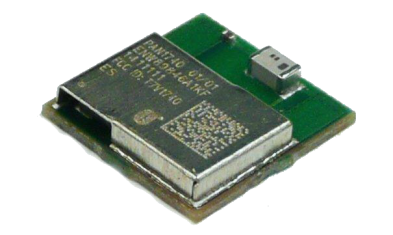
PAN1740 BLE module from Panasonic
Qualcomm
Qualcomm is not generally considered a good supplier for startups. This is because they typically only supply to larger companies. As a measly startup you will get no love from Qualcomm which means no support and sometimes no parts either.
Chip Solution (CSR101x)
Qualcomm (formerly CSR) does however offer a very low cost, popular BLE chip called the CSR101x. It’s based on a proprietary microcontroller running at only 16 MHz and incorporates 128 KB of FLASH memory and 64 KB of RAM memory.
The CSR101x consumes around 20 mA when receiving or transmitting data making it one of the most power hungry BLE chips in this review.
The CSR101x BLE chip was the first solution to offer BLE mesh networking making it a very popular choice for any applications requiring mesh networking capabilities.
Module Solution (Microchip RN4020)
Microchip Semiconductor makes a very popular BLE module called the RN4020 which is based on the CSR101x SoC from Qualcomm. The RN4020 is a mid-priced BLE module that has been on the market for quite a while.
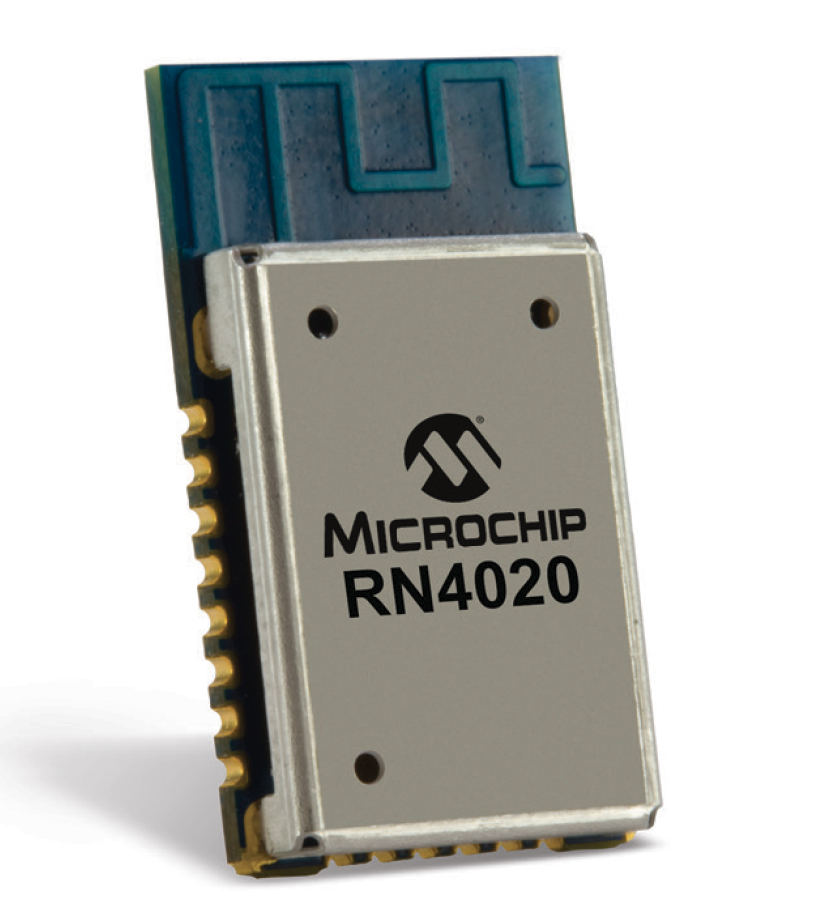
Microchip RN4020 BLE module based on the CSR101x SoC
Atmel
Chip Solution (Atmel BTLC1000)
If low power consumption is critical for your product then Atmel’s BLE chip solution may be your best choice.
The Atmel BTLC1000 has the lowest power consumption specifications of any BLE solution I’ve seen. It consumes only 3.0mA during a transmit and 4.0 mA when receiving data which is considerably lower than the other chips.
Like many of the other BLE solutions I have discussed, the BTLC1000 is based on an ARM Cortex-M0 microcontroller which runs at 26 MHz.
One disadvantage to the Atmel chip is that it doesn’t incorporate any FLASH memory, so a separate FLASH memory chip is required which interfaces to the microcontroller via an SPI interface.
Module Solution (Atmel ATBTLC1000)
Atmel offers their own module based on the BTLC1000 BLE SoC which is called the ATBTLC1000. The Atmel module measures 12.7mm x 20 mm and features an ARM Cortex M0 processor with a 26MHz max clock frequency.
This was previously one of the more expensive BLE modules, but is now very affordable, costing $2.39 for quantities of 1.08k units.
Espressif
Chip Solution (ESP32)
The ESP32 SoC from Chinese manufacturer Espressif is much more than a Bluetooth
Low-Energy chip. It also includes Bluetooth Classic and WiFi radios, along with a fast microcontroller that blurs the line between a microprocessor and a microcontroller.
That being said, the main reason I include this module in a roundup article on BLE solutions is the incredibly low price.
In fact, even though the ESP32 includes WiFi, Bluetooth Classic, Bluetooth Low-Energy, and a 240 MHz microcontroller, it’s still cheaper than any of the other modules discussed here.
The ESP32 is based on an incredibly fast dual core Tensilica LX6 microcontroller. It actually has two separate processor cores that can be controlled individually.
The clock frequency is adjustable from 80 MHz to 240 MHz. So if you don’t need the speed, and instead need to minimize power consumption, you can run it at the lower 80 MHz clock speed.
You can even power down the processor, and instead use the lower power co-processor to monitor various peripherals for activity.
The ESP32 includes a whopping 16 MB of FLASH memory, and 520 KB of RAM memory. All of the other BLE modules discussed include only 32 to 512 KB of FLASH, and 8 to 128 KB of RAM. The other modules use microcontrollers running at only 16 to 64 MHz.
All of the usual interface ports such as GPIO, UART, SPI, and I2C are included with the ESP32. But it also incorporates I2S for serial audio, and includes both ADC and DACs. Espressif has really packed the ESP32 full of features.
So what’s the downside? There must be a tradeoff to all of this extra power and features.
The tradeoff is the power consumption which is around 100mA when using the BLE radio. This is over 10 times the current consumed by the other BLE chips.
Module Solution (ESP-WROOM-32)
The Espressif module, which is based on their ESP32 SoC, costs only $3.59 in quantities of 1k units. When it comes to the biggest bang for your buck the ESP-WROOM-32 module is really unbeatable.
The module dimensions are 25.5 x 18 mm so it’s a little larger than the other BLE modules.
The only other BLE module that comes close in price is the Fanstel BT832A module (based on the Nordic nRF52810), but that solution isn’t yet available.
The BT832A also doesn’t compare in performance to the ESP-WROOM-32, although the power consumption for the Espressif module is about 15 times higher than the BT832A.
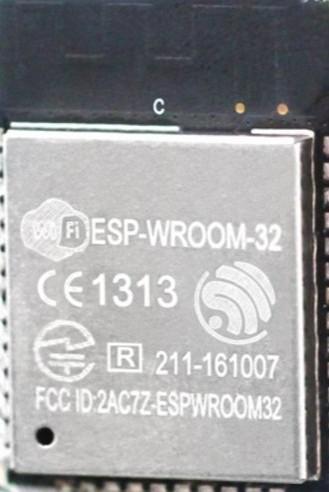
Espressif ESP32 module (ESP-WROOM-32)
Conclusion
So which solution is best? Well, it really depends on your application.
In general, if low power consumption is the most critical specification for your product then I would generally suggest an Atmel, Dialog or Nordic based solution.
If processor performance and power consumption are both critical then I would recommend a Nordic nRF52832 solution.
Is minimizing cost your top priority? If so, then I suggest the Fanstel BT832A or the Fanstel BH678C, or if you can tolerate the high power consumption an Espressif ESP32 solution.
Do you have very little space to fit the module? Then I recommend the Taiyo Yuden EYSHSNZWZ, Fanstel BC832 or Rigado BMD-350. The Panasonic PAN1740 and Cypress EZ-BLE modules are also quite small.
If mesh networking is required then I would recommend one of the Nordic BLE chip solutions, especially the nRF52832. Qualcomm’s CSR101x chip also supports mesh networking, but I don’t really recommend it because of the lack of support.
Finally, if you’re looking for an ultra-fast, high-performance processor then nothing compares to the Espressif ESP32 solution. Additionally, these chips are extremely popular in the hobbyist/Arduino space so you can find lots of online support and documentation for them.
Arduino support is an important consideration to bring up, and is also available for other chips in this list including the nRF52832.
When a chip can be compatible with the Arduino IDE, it can potentially reduce initial prototyping and verification time and increase code portability due to the simplicity and ubiquity of Arduino code and online resources.
Note that for many applications, though, you will eventually want to transition away from the Arduino IDE for programming, but this doesn’t make it less of a great option for getting started and testing your hardware.
There are probably a hundred or more different BLE solutions available, so by no means have I covered them all in this article. I’ve mainly tried to focus on the ones I have personal experience using or that push the limits of performance.


What about silicon labs? They have both SOC and cert modules in house.
I’m curious if anyone has come up with a dead simple BLE SOC for Tag/Beacon applications and such. In other words, when a ton of different interfaces just aren’t needed. I can imagine a BLE SOC with just an SPI or I2C interface on it, and that’s about it. It seems to me for Air-Tag like applications, most of these SOCs are incredibly over-powered. Good article, BTW. It certainly gave me some stuff to think about.
Check out lyra from laird. Already has cert code
I know IoT applications are the main interest for BLE, but what about audio? Do any of these module/SoC suppliers talk about audio and compatible external CODECs?
When was this article written? I can’t seem to find this information anywhere
Another fantastic article. Thanks for this John!
John, have you come across/evaluated https://www.bluexmicro.com/products/? If so, how do you think they compare?
What about STM bluetooth SoC? Where can I find a comparison on radio performances?
Hi John, I am looking at making a bluetooth page turner device that I can stick directly on my guitar. Size is the most important factor, so please could you recommend the chip that would be the smallest and simplest build possible. I only need 4 buttons, scroll up, scroll down and left and right for the next or previous song. It would function like a bluetooth page turner pedal, but would be a lot simpler as a small device to stick directly under or near the strings.
It will work with this app:
https://www.opensongapp.com/make-a-bluetooth-foot-pedal.
In the article, they recommend the bluefruit EZ-key for the pedal, which is discontinued.
Any help and guidance will be greatly appreciated.
Thank you for the message. I would suggest a Nordic module from fanstel.com.
I’ll be happy to help you further in my Hardware Academy program.
Hi, John
Good coverage on BLE. My personal request is to display the timeline of information i.e. date of article, date of comments/replies etc. The technology is moving very fast and new improvements/chip set get introduced quite regularly. A timeline will be helpful to the reader.[I hope I have not failed to notice this information]
Hi John,
Thanks for the indept analysis. I want to build the BLE personal tracker (like Tile or Trackr)
Do you have any sources material on building the hardware and code writing on it.
Thanks
Hi John, is the spreadsheet still available? The download link doesn’t work for me.
Hi Miroslav,
Yes it is still available. I just tested it and everything is working fine for me. Can you perhaps check your spam folder of if using Gmail check the promotions folder? If you can’t find it please email me directly at info@predictabledesigns.com and I’ll be glad to resend it to you.
PSoC has more microcontroller features. You must compare Cypress Wiced products like CYW20719, CYW20735, CYW20819 for better comparison. The solutions from Cypress are relatively very good.
Thanks Ranjith! I’ve kind of gotten away from Cypress modules, and tend to use Nordic based solutions lately.
Thanks for your article. I think about some question. If I already have the main MCU in my design is it a good idea to use BLE-module via HCI or try to move all communication code to BLE-module?
Hi Michael,
Great question! The answer is it depends. If your product is has a low retail price and/or low profit margin then you likely won’t want an extra unnecessary microcontroller. In that case I would run your code onto the module itself as long as the module’s MCU can support all of the other requirements for your product.
If you have higher margins, or a system too complex for the module’s MCU, or if you have developed substantial code already for a specific MCU, then a separate MCU can make more sense.
Best wishes,
John
Hi John,
Great article – I have vast experience with TI and Nordic and and think Nordic is one of the leading companies in BLE solutions. Their chips are really great in most area but also the development tools and support is supper.
Can you please provide the link to the spreadsheet – it currently leads to the home page
Tnx
Hi Avidor,
Thanks so much for your comment and sharing your experience with BLE solutions.
I’m not sure about the issue with the spreadsheet. I just tried it and it worked fine for me. When you click the link in the yellow box you should see a pop-up window open up asking for your email address. You will then receive the link to download the spreadsheet via email. Email me at info@predictabledesigns.com if you are still having issues and I’ll be happy to help.
I have requested through email, please share me the excel.
Good article, but there’s a mistake in the ESP32 section: it doesn’t have integrated flash memory. 16 MB is the maximum for the SPI memory that you have to add. The ESP-WROOM-32 has 4 MB. There also exists the ESP-WROVER-32, with 4 MB extra SPI SRAM.
Thanks for your review.
If you want to know more about the energy consumption of the different BLE devices, you may want to have a look at the following documents with detailed measurements.
Regards
Comparison of BLE solutions 2016 http://pd.zhaw.ch/publikation/upload/210180.pdf
Comparison of BLE solutions 2014 http://pd.zhaw.ch/publikation/upload/207967.pdf
Thanks for this overview. However I think you missed quite a lot real big players in BLE – I.e Silabs, STM etc…
And also when you compare them maybe will be worth to compare some specific parameters like range , current consumption , etc…
Anyway nice article good job
Thanks for the comment Jacek. Yeah there were too many to compare so I had to limit it somewhat, mostly to the chips I have personally used.
Most of the chip and module makers offer many options so I had to limit them otherwise the article would become too overwhelming.
That being said I’ll continue to expand the article over time with some of the other options.
As for comparing them by various parameters that is something I did in the Excel spreadsheet that goes with the article that you can download.
Thanks again!
John
Nice informative article, but I think one of the key factors in choosing a part should be ease of use, from a firmware point of view. This seems to be very difficult to find information on without going into a detailed study of each one. Are you able to shed any light on this for the different solutions?